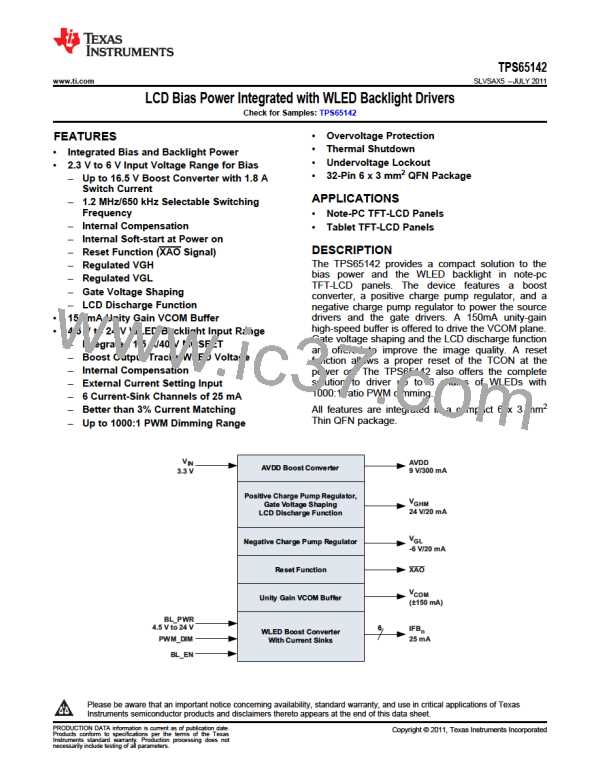TPS65142
SLVSAX5 –JULY 2011
www.ti.com
Current Sinks
The six current sink regulators can each provide a maximum of 25 mA. The IFB current must be programmed to
the highest WLED current expected using an ISET-pin resistor with the following equation:
V
(ISET)
I(FB) = K(ISET)
R(ISET)
(6)
where
K(ISET) = Current multiple (1000 typical)
V(ISET) = ISET pin voltage (1.229 V typical)
R(ISET) = ISET-pin resistor value
The TPS65142 has built-in precise current sink regulators. The current matching error among 6 current sinks is
below 2.5%. This means the differential values between the maximum and minimum currents of the six current
sinks divided by the average current of the six is less than 2.5%.
Unused IFB Pins
If the application requires less than 6 WLED strings, one can easily disable unused IFBx pins by simply leaving
the unused IFB pin open or shorting it to ground. If the IFB pin is open, the boost output voltage ramps up to VO
overvoltage threshold during start up. The IC then detects the zero current string and removes it from the
feedback loop. If the IFB pin is shorted to ground, the IC detects the short immediately after WLED driver is
enable, and the boost output voltage does not go up to VO overvoltage threshold. Instead, it ramps to the
regulation voltage after the soft start.
PWM Dimming
The WLED brightness is controlled by the PWM signal on the DCTRL pin. The frequency and duty cycle of the
DCTRL signal is replicated on the IFB pin current. Keep the dimming frequency in the range of 100 Hz to 1 kHz
to avoid screen flickering and to maintain dimming linearity. Screen flickering may occur if the dimming frequency
is below the range. The minimum achievable duty cycle increases with the dimming frequency. For example,
while a 0.1% dimming duty cycle, giving a 1000:1 dimming range, is achievable at 100 Hz dimming frequency,
only 1% duty cycle, giving a 100:1 dimming range, is achievable with a 1 kHz dimming frequency, and 5%
dimming duty cycle is achievable with 5 kHz dimming frequency. The device can work at high dimming frequency
such as 20KHz, but then only 15% duty cycle can be achieved. The TPS65142 is designed to minimize the AC
ripple on the output capacitor during PWM dimming. Careful passive component selection is also critical to
minimize AC ripple on the output capacitor.
ENABLING THE WLED DRIVER
The WLED driver (including the WLED boost converter and the six current sinks) is enabled when all following
four conditions are satisfied:
1. the VBAT input voltage is higher than its under-voltage-lockout (UVLO) threshold;
2. the REF regulator output is higher than its power-good threshold;
3. the output voltage VO is within 2V of the input voltage VBAT
;
4. and the enable input from the EN pin is high.
Pulling the EN pin low shuts down the WLED driver.
SOFT-START of WLED BOOST REGULATOR
Once the above four conditions are satisfied, the WLED boost converter begins the internal soft-start. The
soft-start function gradually ramps up the reference voltage of the error amplifier to prevent the output-voltage
over shoot and inrush current from the VBAT input.
Protection of WLED Driver
The TPS65142 has multiple protection mechanisms to secure the safe operation of the WLED driver.
22
Submit Documentation Feedback
Copyright © 2011, Texas Instruments Incorporated
Product Folder Link(s) :TPS65142

 TI [ TEXAS INSTRUMENTS ]
TI [ TEXAS INSTRUMENTS ]